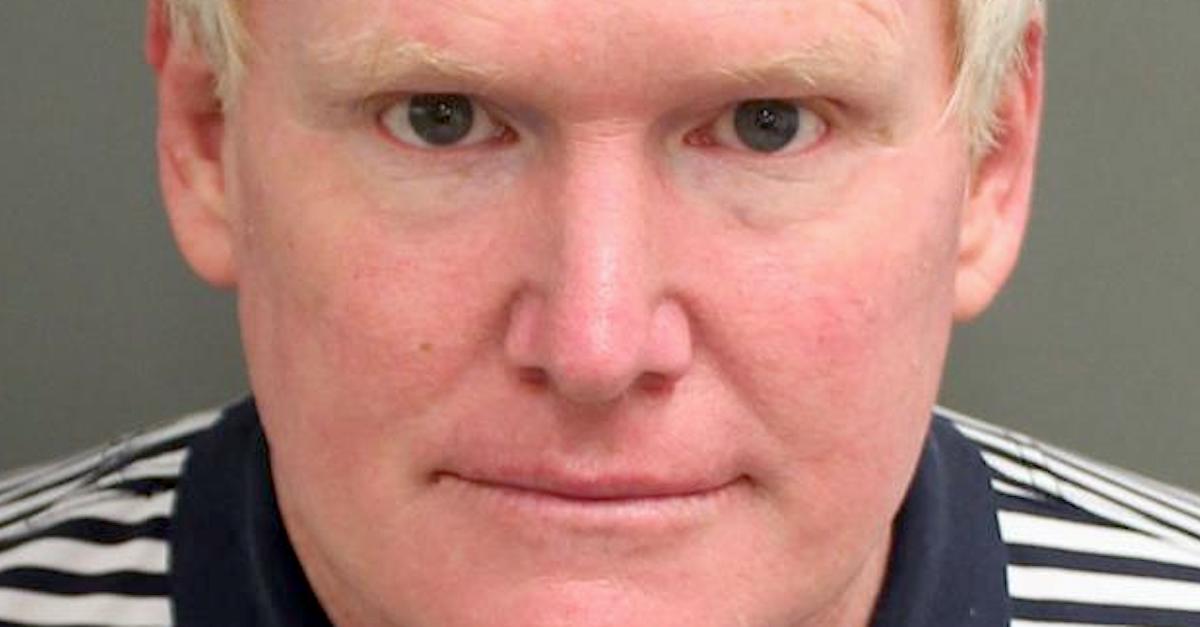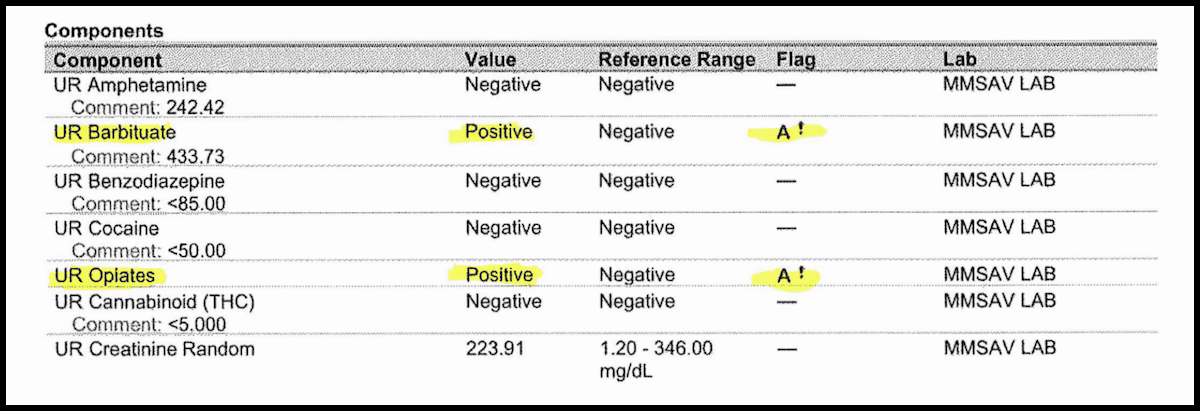
Alex Murdaugh appears in an Oct. 14, 2021 mugshot obtained from the Orange County, Fla. Department of Corrections.
The purported medical records of embattled legal scion Alex Murdaugh show that the now-suspended South Carolina lawyer tested positive for two types of drugs — barbiturates and opiates — when doctors examined him after a roadside shooting that eventually left him facing a scad of criminal charges.
A public relations firm working with Murdaugh and his attorneys released four pages of what it claims to be Murdaugh’s “medical records” on Friday without explanatory comment. The records were purportedly maintained by Memorial Health in Savannah, Georgia. The four pages of records are facially incomplete: the pages are numbered seven, eight, and 48; a fourth page contains no page number.
The records suggest a “rapid drug screen” on Murdaugh’s urine contained the two aforementioned drugs but did not contain cocaine, amphetamines, benzodiazepine (the type of tranquilizer drugs contained in Valium or Xanax), or cannabinoids (THC) from marijuana.
“No attempt is made to identify specific drugs that may be present or any other drugs that may cause false positives,” the documents noted.

A section of Murdaugh’s medical records indicates that a blood draw tested positive for two types of drugs.
In response to a telephone inquiry from Law&Crime concerning the authenticity of the documents, a spokesperson at Memorial Health issued a brief and wholly expected statement about the release of the material.
“Due to patient privacy laws, we cannot comment on requests like this,” the statement read.
Federal health privacy laws generally allow medical providers to furnish health care documents to law enforcement agencies pursuant to warrants or subpoenas.
The South Carolina Law Enforcement Division (SLED), which is investigating Murdaugh on multiple fronts, also did not immediately return an email seeking to authenticate the material or to provide additional reaction or comment.
The PR firm which released the material did so with only a two-line explanation.
“We have received numerous requests for the medical records for Alex Murdaugh so here are a few pages from those documents that lay out the specifics of Alex’s injuries and medical treatment,” the note attached to the records explains. “Other than providing these records, we will not be offering any other comments at this time.”
Several entries in the documents are highlighted yellow. It is unclear who penned those highlights.
The documents further indicate that Murdaugh suffered an entry and exit wound from the bullet he allegedly hoped would end his life. The resulting injury was described as a “hemostatic GSW [gunshot wound] entry exit to posterior scalp” – suggesting that bleeding had stopped when doctors examined Murdaugh.
The heir to a South Carolina legal dynasty also suffered a “parietal bone fracture” — that’s the bone in the upper rear of his skull — and exhibited “displaced” bone “fragments,” the documents continue A “[s]calp laceration” was visible his head.
The records elsewhere say Murdaugh was “negative for acute injury” — in other words, the wounds were not serious.
Murdaugh was subsequently charged with asking his alleged drug dealer to kill him so that his son could pocket a $10 million insurance policy. Curtis Smith, 61, claims he is “innocent” and that the Sept. 4 incident was a “setup.”
“I didn’t shoot him,” Smith told TODAY on Thursday. “I’m innocent. If I’d have shot him, he’d be dead. He’s alive.”
The newly released medical materials contain several brief recaps of the early factual assertions: that Murdaugh stopped to change a flat tire and that an “unknown assailant” shot him in the back of the head. Murdaugh told emergency doctors that “he immediately lost his vision” but that it “slowly returned over time.”
SLED alleges that Murdaugh’s then-assertion that his assailant was “unknown” was a lie.
“He was able to call EMS himself,” the records continue. Murdaugh was “awake and alert and hemodynamically stable.”
“Head to toe examination . . . revealed two superficial appearing bullet wounds to the posterior scalp with no active hemorrhage,” the records elsewhere state. “No other external signs of trauma” were found.
“He was complaining of continued abnormal vision,” they later indicated. “X-ray of the head and chest revealed no acute traumatic findings ore retained ballistic fragments.”
During a Sept. 16 court appearance, Murdaugh’s attorneys characterized their client as a suffering opioid addict who was pushed “over the edge” by the murders of his wife Maggie Murdaugh and son Paul Murdaugh over the summer (an attorney for Alex Murdaugh acknowledged this week that his client is considered a person of interest in the double homicide). Murdaugh’s lawyers say addiction and grief led Murdaugh to attempt to secure his own untimely death.
Various South Carolina authorities have alleged — and Murdaugh’s legal team has acknowledged — that the famed family’s finances were crumbling.The earlier death of Murdaugh’s housekeeper Gloria Satterfield resulted in a civil lawsuit and criminal financial charges. Murdaugh was also accused of stealing client funds through his former law firm immediately before he was shot.
Paul Murdaugh had been charged in an alleged drunken boating crash which killed local teenager Mallory Beach, 19. Civil suits connected to that crash are ongoing, and one of Murdaugh’s major insurers dodged having to pay for the crash — potentially leaving the family on the hook for a large financial settlement.
According to jail records, Murdaugh remains in a Florida jail as of early Friday afternoon. He was arrested in the Sunshine State on Thursday after leaving a drug rehab center on a second set of charges connected to his alleged financial wranglings in the wake of Satterfield’s death.
Read the documents below as provided to Law&Crime by Murdaugh’s public relations firm.